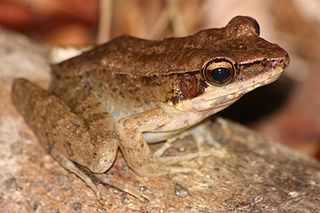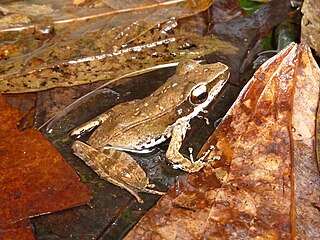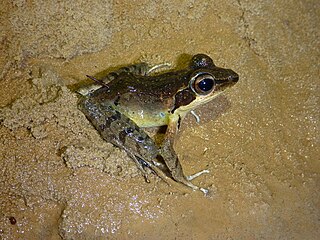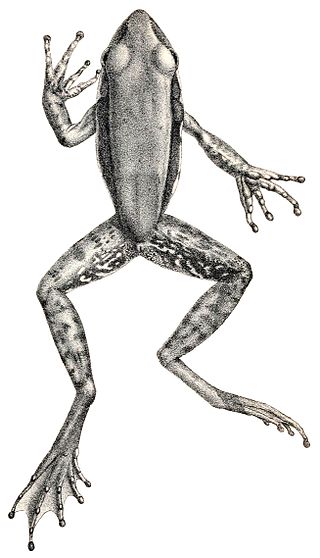
Papurana daemeli is a species of "true frog", family Ranidae. It is found in New Guinea, northern Australia, and some smaller islands. It is the only ranid frog found in Australia. In Australia, the species is restricted to the rainforest of northern Queensland and the eastern border of Arnhem Land, in the Northern Territory. In Australia, it is usually known as wood frog or sometimes as water frog. Other vernacular names are Australian wood frog, Australian bullfrog, and Arnhem rana.
Aphantophryne parkeri is a species of frog in the family Microhylidae. It is endemic to the north coast of New Guinea and only known from Matapan and the Bewani Mountains in the West Sepik Province, Papua New Guinea, and from Sentani in the Papua Province, Western New Guinea (Indonesia). This species was formerly included in the genus Oreophryne, but was in 2017 moved to Aphantophryne based on molecular data. The specific name parkeri honours Hampton Wildman Parker, an English zoologist and herpetologist. Common name Parker's cross frog has been coined for it.
Papurana garritor is a species of frog in the family Ranidae. It is endemic to New Guinea and widely distributed, found in both Indonesian and Papua New Guinean parts of the island. Common name Eilogo Estate frog has been coined for it.

Papurana is a genus of frogs in the family Ranidae, "true frogs". They are known from Southeast Asia, New Guinea, and northern Australia. Papurana daemeli is the only ranid frog found in Australia.
Papurana arfaki is a species of true frog, family Ranidae. It is widely distributed in New Guinea and also found on the Aru Islands (Indonesia). Common names Arfak Mountains frog and large river-frog have been coined for it. Its type locality is the Arfak Mountains.
Papurana attigua is a species of frog in the family Ranidae, the "true frogs". It is found in central and south Vietnam, eastern Cambodia, and southern Laos. The specific name attigua is derived from Latin attiguus meaning "neighbor". It refers to the similarity of this species to Indosylvirana milleti. The common name similar frog has been coined for this species.
Papurana aurata is a species of true frog, the family Ranidae. It is only known from the area of its type locality near Nabire, in the Indonesian province of Papua, in New Guinea. The specific name aurata is Latin and refers to the gold-like colour of adult males.

Papurana celebensis, also known as the Celebes frog, is a species of true frog in the family Ranidae. Prior to being reclassified into the genus Papurana in 2020, it was referred to as "Hylarana" celebensis. It is endemic to Sulawesi (Celebes), Indonesia. It is a lowland forest species, also occurring disturbed habitats. It has been observed between 326 to 1075 meters above sea level.

Papurana elberti is a species of true frog. It is native to Indonesia and Timor-Leste and found on the islands of Timor and Wetar. The specific name elberti honours Johannes Elbert, a German naturalist who joined an expedition to the Lesser Sunda Islands and Sulawesi in 1910. Common name Lesser Sundas frog has been coined for it.

Papurana florensis is a species of true frog. It is native to the islands of Lombok, Sumbawa, and Flores in Indonesia. Common names Floresian frog and Flores frog have been coined for it.
Papurana grisea is a species of true frog. It is known with certainty only from its type locality in the Went Mountains, in the Indonesian province of Papua, New Guinea. Similar frogs are widespread in New Guinea, usually above 1,200 m (3,900 ft) above sea level, as well as on the Seram Island, but their identity is uncertain; they possibly represent another, undescribed species. Common names Went Mountains frog and Montaen swamp frog have been coined for it.

Papurana kreffti is a species of true frog, family Ranidae. It is native to New Ireland and Buka Island and the Solomon Islands. The specific name kreffti honours Gerard Krefft, a German adventurer who settled in Australia and became there to be regarded as the father of Australian herpetology. Common names San Cristoval frog and San Cristobal treefrog have been coined for it.
Papurana milleti is a species of true frog. Originally described in the genus Rana, then Hylarana and Indosylvirana, it is now placed in Papurana. It is native to Cambodia, China (Yunnan), Thailand, Vietnam, and quite possibly Laos. It is a locally common frog found by ponds and streams in seasonal tropical forests.
Papurana milneana is a species of "true frog", family Ranidae. It is endemic to Papua New Guinea where it is found in the upland areas of Milne Bay, Morobe, Northern, and Central Provinces, as well from the D'Entrecasteaux Islands and, tentatively, Louisiade Archipelago. It was originally described as a subspecies of Rana grisea, but raised to full-species status in 2007.

Papurana moluccana is a species of true frog. It is endemic to the Maluku Islands of Indonesia; specifically, it is known from Halmahera and Bacan. Common name Moluccas frog has been coined for it.
Papurana novaeguineae is a species of true frog, family Ranidae. It is endemic to southern New Guinea and occurs between Lake Yamur and Purari River. Common name New Guinea frog has been coined for it.

Papurana papua is a species of true frog, family Ranidae. It is endemic to New Guinea and found in the northern part of the island in both Indonesia and Papua New Guinea as well in some offshore islands. Common name Papua frog has been coined for it.
Papurana supragrisea is a species of true frog, family Ranidae. It is endemic to New Guinea, including some nearby islands. It is known with certainty only from southeastern New Guinea and from the D'Entrecasteaux Islands. However, this name has been used more broadly for a species complex that is widely distributed in the mountains of New Guinea. Common name Papua gray frog has been coined for it.
Papurana volkerjane is a species of true frogs, family Ranidae. It is endemic to New Guinea and is known from its type locality, the eastern slopes of the Wondiwoi Mountains, from the Fakfak Mountains, and from the Bewani and Torricelli Mountainss in the West Sepik Province, Papua New Guinea. Rainer Günther named the species after his son Volker and daughter-in-law Jane.

The Guinean montane forests are a tropical moist broadleaf forest ecoregion of West Africa.









